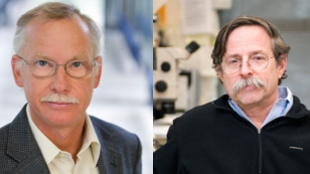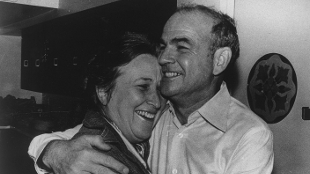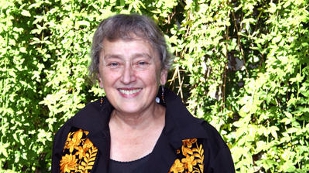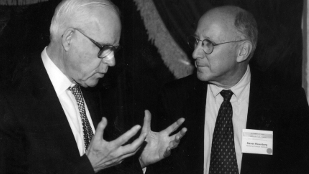The last 12 months of scientific achievement are reflected in the researchers that made significant contributions to their fields. Here, The Scientist reviews some of the most popular scientists in this year’s headlines, recognized with prestigious scientific awards or remembered upon their passing.
Top Science Awards of 2011:

Three immunologist shared this year’s Nobel Prize in Physiology or Medicine—Jules Hoffmann of the University of Strasbourg in France, Bruce Beutler of Scripps Research Institute in California, and Ralph Steinman of The Rockefeller University in New York. Hoffmann and Beutler shared half of the award for their discovery that the Drosophila Toll gene regulates the fly's immune response against bacteria and fungi, while Steinman took the other half of the award for first describing the immune system’s dendritic cells...
Sadly, Steinman passed away from pancreatic cancer in September, just three days before the Nobel recipients were announced. “Ralph has changed my life in many ways,” Steinman’s former post-doc Gerold Schuler, head of the department of dermatology at the University Hospital Erlangen in Germany, told The Scientist. “[He was a] deeply caring and understanding human being…. I am very sad that he passed away, notably without having the chance to enjoy becoming a Nobel Laureate.” Steinman’s own life was extended using a dendritic cell-based immunotheraphy of his own design.
But the Nobel was later tainted with accusations by Hoffmann’s former lab member, Bruno Lemaitre, who alleged that Hoffmann, did not participate in the research that led to the prize. Lemaitre was a research associate in Hoffmann’s lab at the at the National Centre for Scientific Research (CNRS) from 1992 to 1998 and the first author of the 1996 Cell paper where the finding was reported. He claimed that Hoffmann did not express any interest in his work on Toll.
“Jules never provided any ideas for my project, being very far from the realities of experimental bench work…[and] was not very supportive of the genetics approach I had undertaken,” Lemaitre wrote in a story outlining his take on the prize-winning work. “Subsequently, he has never been able to fully recognize my contribution, yet somehow it is he who is now collecting the honours for my work.”

Two pioneers in the field of protein folder—Franz-Ulrich Hartl of the Max Planck Institute of Biochemistry and Arthur L. Horwich of Yale University School of Medicine—earned this year’s Albert Lasker Basic Medical Research Award. When protein folding mechanisms are compromised in the cell, it can lead to neurodegenerative diseases such as Alzheimer’s and amyotrophic lateral sclerosis. Hartl and Horwich won the award for their identification of chaperonin, a cage-like structure that protects nascent proteins from becoming tangled with other proteins as it guides the folding process.
The Albert and Mary Lasker Foundation awarded its Lasker~DeBakey Clinical Medical Research Award to Tu Youyou of the China Academy of Chinese Medical Sciences for her discovery of artemisinin, an anti-malarial drug that has “saved millions of lives across the globe, especially in the developing world,” according to the Lasker announcement.
The John D. & Catherine T. MacArthur Foundation awarded 22 of its annual fellowships, five of which went to life science researchers. This year’s winners will receive a monetary prize of $500,000 over the next five years with no stipulations on how the money should be spent and no reporting requirements.

- Elodie Ghedin, University of Pittsburgh, for her studies of parasites and diseases endemic to tropical climates, such as leishmaniasis, river blindness, Chagas disease and elephantiasis
- Kevin Guskiewicz, University of North Carolina, Chapel Hill, for his research on sports-related concussions and the long-term neurological effects of such injuries.
- Sarah Otto, University of British Columbia, for her work on gene copy number variation and sexual reproduction
- William Seeley, University of California, San Francisco, for his clinical fMRI and microscopic studies of neurodegenerative diseases like frontotemporal dementia.
- Yukiko Yamashita, University of Michigan Medical School won the fellowship for her studies on the asymmetric division of stem cells
Top Scientists that Passed Away in 2011

Baruch "Barry" Blumberg was a renowned virologist, travelling around the world in the 1960s collecting blood samples from different ethnic groups to eventually identify the hepatitis B virus (HBV). He went on to help develop diagnostic tests and a vaccine for the virus, which can cause debilitating liver disease and even liver cancer. He shared the 1976 Nobel Prize in Medicine or Physiology for his work on this and other infectious diseases. “Barry probably was responsible for preventing more cancers than any scientist that ever lived,” Jonathan Chernoff, chief scientific officer at the Fox Chase Cancer Center, told The Scientist. “He was doing what we now call translational medicine long before people had created that term.” He died in April at age 85 of an apparent heart attack while attending a conference on astrobiology in California.

Baruj Benacerraf was a geneticist and immunologist who took home a 1980 Nobel Prize for his discovery of the gene that governs the immune system’s reaction to foreign bodies, later recognized to be the major histocompatibility complex (MHC) molecule. He identified the gene at New York University’s School of Medicine after immunizing a group of guinea pigs with a synthetic antigen and observing that only about 40 percent of the animals developed an immune response. Comparing responders with non-responders, he found that the individual variation in immunity was controlled by a single dominant gene. “He felt that if you focused on the research, and the quality of the data, and the insights it provided, everything would come from that.” Steven Burakoff, director of the Tisch Cancer Institute at Mount Sinai Medical Center, told The Scientist. He died in August of pneumonia at the age of 90.
A 1968 Nobel Laureate for his contributions towards decoding the language of DNA and RNA, Har Gobind Khorana, professor emeritus at the Massachusetts Institute of Technology, was renowned in the molecular biology world. He went on to identify the start and stop codons that marked the beginnings and ends of proteins, and even constructed a gene from raw nucleic acids. He died in November of natural causes. “He left an amazing trail of technical achievement,” Thomas Sakmar, a professor at Rockefeller University and a former student of Khorana’s told The New York Times. He died in mid-November at age 89 of natural causes.

Evolutionary biologist Lynn Margulis got off to an early start in science, earning her bachelor’s degree in zoology from the University of Chicago at age 19, and her PhD from the University of California, Berkeley, 6 years later. In the late 1960s, she proposed that new species were likely derived from parasitic or symbiotic relationships that became permanently inter-dependent over time—a theory called endosymbiosis. Though it was highly controversial at the time—it took her 15 tries before a journal (the Journal of Theoretical Biology) finally accepted her manuscript on the topic—serial symbiosis is widely accepted today. “She was always stimulating; she always had a new idea, some new connection she had seen and she couldn’t wait to tell you about,” Steve Goodwin, Dean of the College of Natural Resources and the Environment told MassLive.com. She died in November at the age of 73.

In his career, Lloyd Old, a pioneer and long-time supporter of the concept of attacking caner by rousing the immune system, served as scientific and medical director of the Cancer Research Institute (CRI) and director of The Ludwig Institute for Cancer Research, a non-profit organization that conducts basic cancer research around the world. Among his many achievements, Old discovered tumor necrosis factor (TNF), an immune factor that can kill cancer cells almost instantly. Because the immune system will attack only foreign substances, Old believed it could be used to target cancer without the side effects associated with most cancer drugs and therapies. “He was an intellectual giant,” Jim Allison current director of CRI’s scientific advisory council told The Scientist. He died in late November from prostate cancer at the age of 78.




